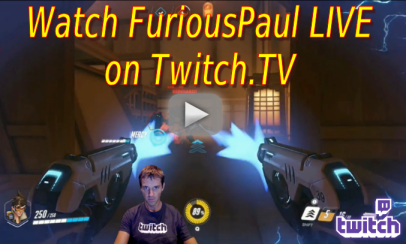How the Mechanics Work in Overwatch
( FP's Overwatch Strategy Guide )
This guide will cover all the basic things you need to know about Overwatch, including: how hero abilities work, switching of heroes during a game, ammo, death, melee attacks, crouching, etc..

Overwatch Basics
Hero Introductions |
 |
Hero Abilities
Every hero has a basic attack weapon with two basic abilities and an ultimate
ability. Some heroes have an alternate fire for their basic attack weapon
as well. Some heroes have passive abilities that are unique to them and
don't require cooldowns.
Ability buffering
One very important trick you should be aware of with abilities is that they can
be buffered in a sense where you can hold down the hotkey for an ability and
your hero will use that ability again immediately when it becomes available.
This only works though when pressing the button again during the cooldown of an
ability. If you press the hotkey down again before the cooldown, it will
not execute again immediately when the cooldown is up for it. This trick
is very important for so many abilities in Overwatch. For example, when
playing Soldier 76, after using a Biotic Field and the cooldown for it begins,
simply press and hold the hotkey down for that ability so it will be used again
immediately once the cooldown is up for it.
Here is a list of abilities where ability buffering tends to be more useful for:
- Pharah's Jet Packs
- Winston's Barrier Projector
- Soldier 76's Biotic Field
- Roadhog's Take a Breather
- McCree's Combat Roll or Flashbang
- Zarya's Particle Barrier
- Tracer's Recall
- Mei's Cryo-Freeze
And of course there are many more abilities that can take advantage of this trick.
Ultimates
The ultimate ability for each hero gets charged up slowly overtime automatically
(even when doing nothing), and gets charged up faster when you deal damage to
enemy heroes. Healing or self healing also charges ultimates.
Dealing damage to objects such as turrets do not charge up ultimates. When an ultimate charge is at 100% you
can then use the ability once. Once the ultimate is used, the charge meter
will be reset (or partially reset depending on how it was executed).
Ultimates are generally significantly more powerful than basic abilities and can
easily turn the tide of the battle around in your favor.
Enemy ultimates will sound louder and be in the native language of the hero, while allied ultimates will generally be "softer" and always be in the language of the game you are playing (usually English).
Click here for an audio/visual differences for all ultimates for both enemies and allies.
Ultimate Charge Rates
| Hero |
0 - 100% Passive Ult Charge |
Damage Done Per 1% |
Ultimate Charge For Healing (or self healing) |
|---|---|---|---|
| D.va (Call Mech) | 1:15 | 3 | |
| Symmetra (Teleporter) | 3:20 | 8 | |
| Tracer (Pulse Bomb) | 3:45 | 9 | |
| Ana (Nano Boost) | 4:35 | 11 | 8% for a full Biotic Grenade heal, 6% for Biotic Rifle shot. |
| Widowmaker (Infra-Sight) | 4:35 | 11 | |
| Reinhardt (Earthshatter) | 4:35 | 11 | |
| D.va (Self-Destruct) | 4:35 | 11 | |
| Winston (Primal Rage) | 4:35 | 11 | |
| Mei (Blizzard) | 4:48 | 10 | 4% per second while in a Cryo-Freeze |
| Genji (Dragonblade) | 5:00 | 12 | |
| Hanzo (Dragonstrike) | 5:00 | 12 | |
| McCree (Deadeye) | 5:00 | 12 | |
| Junkrat (Rip-Tire) | 5:11 | 12.5 | |
| Mercy (Resurrect) | 5:03 | 13 | 4% per second when healing allies. Damage Boosting charges 1% for 15 damage done. |
| Torbjorn (Molten Core) | 5:03 | 13 | |
| Pharah (Barrage) | 6:15 | 15 | |
| Reaper (Deathblossom) | 6:15 | 15 | Soul Globes do NOT give ultimate charge. |
| Zarya (Graviton Surge) | 6:15 | 15 | |
| Roadhog (Whole Hog) | 6:40 | 16 | 18% for a full Canister healing |
| Bastion (Tank Form) | 6:52 | 16.5 | 6% per second while Self-Healing |
| Soldier 76 (Tactical Visor) | 6:52 | 16.5 | 3% per second while under Biotic Field |
| Zenyatta (Transcendence) | 6:52 | 16.5 | 1.4% ult charge a second when Harmony Orb is healing |
| Lucio (Sound Barrier) | 8:45 | 21 | 1% for 15 healing done. |
NOTE: Receiving healing from support healers does not increase the ultimate charge of the hero receiving the support heal.
This list can give you a rough estimate of which heroes can reach their ultimates quicker than other heroes. By looking at the list you can see that D.va's Call-Mech (not really an ultimate) gets revved up the fastest. Symmetra's Teleporter is the second fastest, but keep in mind that Symmetra does not gain ultimate charge if she already has a Teleporter out, but she can get another one relatively fast once her current one gets destroyed. Tracer's Pulse Bomb is 3rd and she can use her ultimate very often.
There are some other important ultimates that get charged up relatively fast that's important to keep in mind, such as: Mercy's Resurrect and Widowmaker's Infra-Sight.
Some of the ultimates that get charged up the slowest and are lowest on the list includes ultimates that provide teams with a powerful "push" ability, such as Zenyatta's Transcendence and Lucio's Sound Barrier.
Switching heroes during a game
Overwatch was designed so that you can switch heroes during a game. You
can only change your heroes in the spawn locations, and you can do so anytime as
long as you do it in your team's spawn location.
Why is this allowed? Switching of heroes during a match lets you have more opportunities to counter the enemy. In Overwatch, certain heroes will counter other heroes. By knowing who counters who you can make better hero choices to counter the enemy more effectively. TIP: You can browse my guide to see all the hero counters on all the individual hero pages. Memorize them as best as possible and you will be better educated on knowing which heroes to pick during matches.
While playing if you see you are continuously dying to the same hero, then you should highly consider switching to a different hero that counters that specific enemy hero.
Keep in mind when switching heroes you will lose any ultimate charge that was built up for the specific hero you was playing. You may want to get your ultimate out first before switching heroes.
Ammo & Reloading
Players have infinite ammo, but reloads are needed on most weapons in the game.
You can see how much ammo a clip holds along with how much your current clip in
use has left, as shown below:
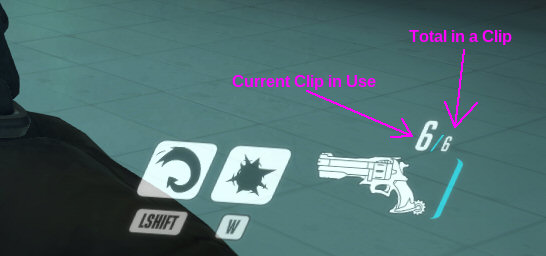
The following lists heroes that use weapons that does not require reloading:
- D.va's Fusion Cannons
- Reinhardt's Rocket Hammer (melee swings)
- Torbjorn's Turrets
- Hanzo's bow
Melee attacks
All heroes can do a melee attack that does 30 damage. The only exception
to this is Reinhardt and Torbjorn's Forge Hammer. Reinhardt's melee attack works completely different
than everyone else. Reinhardt does 75 damage in a wide ark in front of him
that also knocks back enemies. Torbjorn's Forge Hammer acts like any other
melee weapon except it does 75 damage. When Torbjorn uses his Rivet Gun,
he does a normal melee attack of 30 damage.
Melee attacks are usually worth doing once you get close to an enemy as you will be able to dish out more overall damage. Melee attacks are also very useful to use instead of reloading your gun if you have the opportunity for it. Melee attacks will also interrupt reloading as it has a higher priority of use.
Important hero melee combos:
- Roadhog's Chain Hook, then melee combo.
- Tracer's unload clip, then melee.
- D.va Boosts up to an enemy then melee.
- Mei freezes target, then melee.
- Genji Swift Strikes to an enemy, then melee.
Learn How Abilities Affect Reloading
Keep in mind that some abilities and all melee attacks will interrupt the reload animation and actual
reload if it didn't complete in time. So you can always cancel a reload if you
need to use an ability or melee someone to finish them off quickly instead. But this also
means you may miss the point of actual reload. You should memorize exactly
when a gun gets reloaded vs how the gun sounded and looked at that exact time.
I highly recommend using sound as the main cue for knowing exactly when you have
reloaded (at least on most guns), but memorizing both the visual state of the
gun and the actual sound at time of reload is key. Practice this by just
shooting and looking at your ammo count and gun animation at the same time.
Find out where it barely makes the reload before it gets canceled out by an
ability (or melee attack). This will allow you to be more proficient at
reloading and then getting back to the fight ASAP.
Here is a video showing the actual reload states for all weapons.
Death
When you die you have to wait a set amount of time before returning back to the
game, as shown below:
- If you are on Attack, the death timer is 10 seconds (12 seconds during Overtime).
- If you are on Defense, the death timer is 10 seconds (12 seconds during Overtime).
While you are dead, your allies will see a death timer on your corpse, like this:
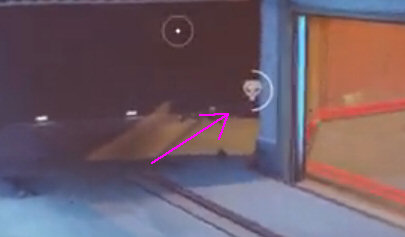
A death will also set you back a bit more than this because you will then have to run back to the fight, which can take an average of 10 additional seconds. When you respawn back to the game you will spawn in your team's last spawn room checkpoint.
While you are dead you can immediately switch to a different hero to play with if you choose to. Also by default, you will see a "kill cam" showing exactly how you died. A lot of players don't like watching this, but I feel like it's important to watch how you died so you can figure out what you should have done differently to have prevented that death. Remember, when it comes to getting better at any video game, your failures is your keys to improving by learning from your mistakes.
No fall damage
When falling from long heights, you will not take any damage when landing on the
ground.
Max Damage Reduction
The total damage reduction that a hero can receive while buffed (e.g. from Ana's
Nano Boost and Orisa's Fortify) is capped at 50%.
Hero Collision
In Overwatch you can clip through other allies, as you can walk right through
them. However, you cannot clip through enemies, they will act as "walls"
that you cannot run through. You can also stand on top of enemies. The exception to this is that Genji can
Swift Strike
through enemies, Tracer can
Blink
through enemies and Reaper can
Wraith Form
through enemies.
If you run or crouch walk against an enemy you can push them very slowly.
Friendly Fire
This refers to being able to shoot and damage your own teammates. Overwatch does
NOT use Friendly Fire. If fact, there is no weapons or abilities in Overwatch that
can be used to damage your own teammates. However, there is self-damage.
You can hurt yourself with certain abilities.
All abilities with Self-Damage:
- Junkrat's Frag Launcher
- Junkrat's Rip-Tire
- Soldier 76's Helix Rockets
- Zarya's charged particle shots
- Tracer's Pulse Bomb
- Pharah's rocket Launcher & Barrage
- Widowmaker's Venom Mines
Footsteps
Every hero in Overwatch has a unique footstep sound. You should memorize
all these sounds so you will be aware of what enemies (or allies) are around you
at any given time. Generally, the heroes with the loudest footstep sounds
will also be the ones that are the most deadly close up. So definitely
keep this in mind. Zenyatta is the only hero in the game that does not
have footstep sounds (he simply hovers around).
Here is a video guide showcasing all footstep sounds for Overwatch.
It's also important to know that enemy footsteps are much louder and clunkier than allied footsteps. Allied footsteps are MUCH softer and less audible than enemy footsteps.
Crouching
All heroes can crouch (except D.va in mech form). Crouching has a few
purposes. Crouching will soften the sound of your footsteps and make it
quieter, this is great for when you are trying to sneak up on someone unnoticed.
Crouching up to these specific enemies can be useful:
- A Widowmaker or Ana sniping - When a Widowmaker (or to a lesser degree, Ana) is in sniper mode, their field of view is very narrow and they can only see so much around them at once. They rely heavily on footstep sounds to warn them of incoming flankers.
- A Bastion in Sentry Mode - Crouching up to a Bastion Sentry is a little scarier than a Widowmaker, as a Bastion Sentry can still turn around 360 degrees and has a large field of view. But they are stationary and crouching up to them is still effective for the most part.
- A Hanzo - Many times you will see a Hanzo in one specific spot sniping away with his bow. Sneak crouching up to him can be effective if you manage to get close to him.
Crouching is also useful for taking better cover behind payloads, or for Widowmaker's sniping to provide better protection.
Overtime
Overtime is a condition in which the time limit ran out but both teams are still
contesting the objective. A fuse will go up or down depending on how many
defenders there are relative to attackers contesting the objective. If
there are no more attackers contesting the objective the fuse will count down
and the game will be over. During Overtime both attackers and defenders
will have a 2 second longer respawn time, this is to ensure the game will end
quicker and not stay in Overtime for too long.
Overwatch Hero Introductions - Basics Guide
How the Mechanics Work in Overwatch
How Headshots Work In Overwatch
Overwatch Game Modes Overview
Overwatch Health Types & Hitpoint Basics
Overwatch Terms, Abbreviations, & Their Meanings
News/Home | Blog | Follow | Unlock Full Guide
Easiest and Hardest Overwatch Heroes to Master
My Hotkey
Bindings For Overwatch & Why I Use Them
|
Feel free to leave any type of comment, such as how you like the guide and if it helps you at all, or to report something that is inaccurate in the guide. |

 Genji
Genji Bastion
Bastion D.va
D.va Ana
Ana McCree
McCree Hanzo
Hanzo Reinhardt
Reinhardt Lucio
Lucio Pharah
Pharah Junkrat
Junkrat Roadhog
Roadhog Mercy
Mercy Reaper
Reaper Mei
Mei Winston
Winston Symmetra
Symmetra Soldier76
Soldier76 Torbjorn
Torbjorn Zarya
Zarya Zenyatta
Zenyatta Sombra
Sombra Widowmaker
Widowmaker Tracer
Tracer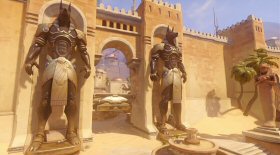 Temple of Anubis
Temple of Anubis Hanamura
Hanamura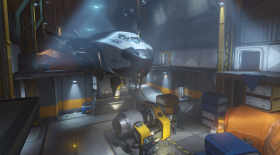 Watchpoint Gibraltar
Watchpoint Gibraltar